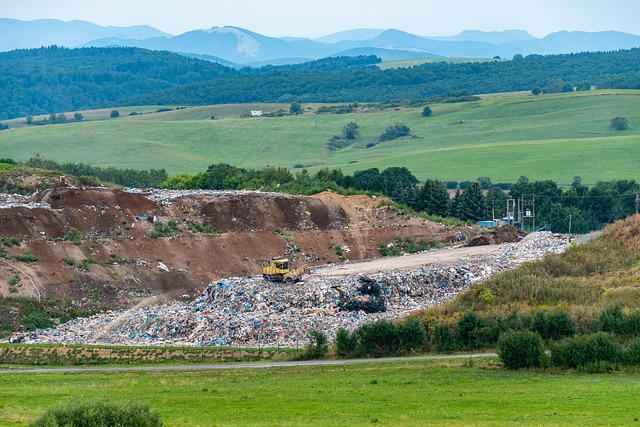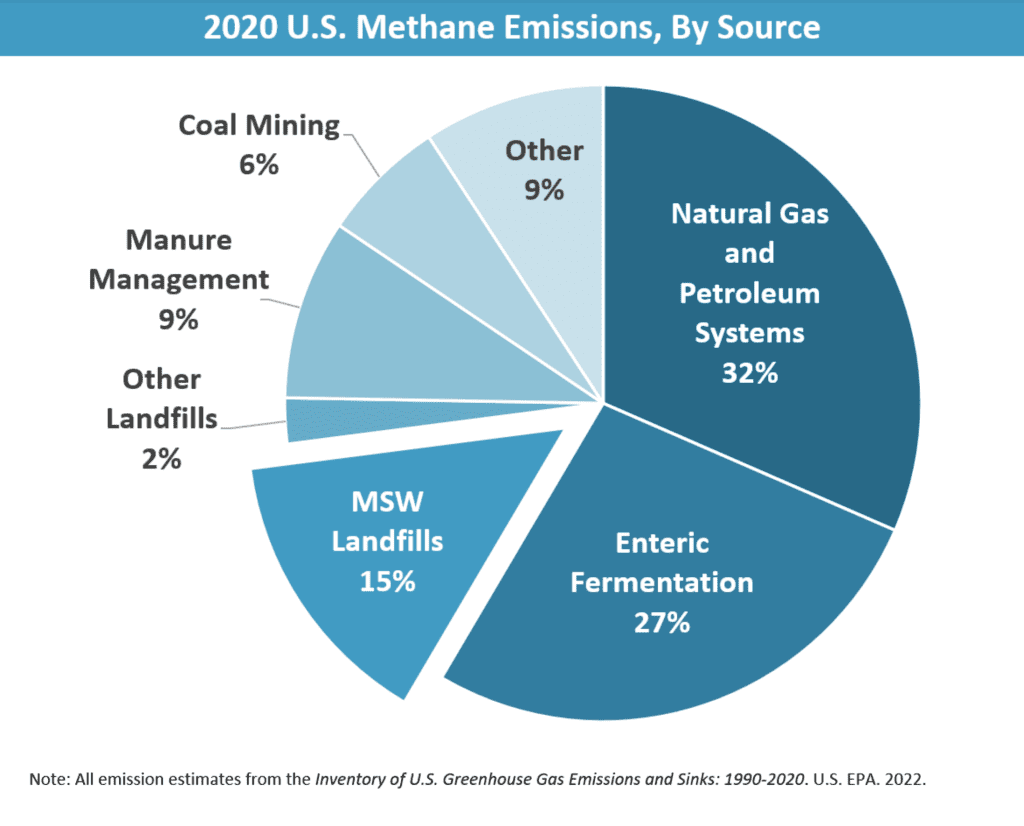Recycling And The Link To Landfill Gas
Most of us do our bit to recycle. But do you know why we should recycle? Anything you don’t recycle ends up in a landfill. A landfill, also known as a dump, holds something called “Municipal Solid Waste” or MSW. What is MSW? In this article we discuss recycling. There’s another philosophy that’s very helpful called “zero-waste” and simple ways to go zero-waste will also reduce carbon emissions.

The City Landfill Is A Massive Source Of Carbon Emissions
Municipal solid waste (MSW) is nonhazardous solid waste, including garbage, construction and demolition debris, and other solid waste generated by households and businesses, that is collected and transported to MSW landfills, where it is disposed. MSW, also known as landfill gas, is a major source of carbon emissions through methane equivalent and carbon dioxide.
How Much Methane Do MSW Landfills Emit?
In 2020, MSW landfills emitted approximately 132.5 million metric tons CO2 equivalent (MMTCO2e) of methane, which was equivalent to the GHG emissions from about 20.3 million passenger vehicles driven for one year or the CO2 emissions from nearly 11.9 million homes’ energy use for one year.
Methane emissions from MSW landfills were the third-largest source of human-related methane emissions in the United States in 2020, accounting for approximately 14.5 percent of these emissions. Methane is a potent greenhouse gas.

Recycling Reduces Carbon Footprint
Therefore recycling reduces carbon emissions because it reduces methane emissions from landfills. A ton of waste recycled emits approximately 1 ton of carbon dioxide. In addition, a ton of waste carries with it a hidden production cost in carbon emissions. Paper for example carries a 20 kg CO2 per ton carbon footprint via its production.
Paper, in addition, carries a second hidden cost because its manufactured from wood pulp, all of which come from trees which are one of our best carbon sinks. Therefore will recycling paper reduces carbon emissions in two ways: 1) the ton of direct emissions from the waste decaying in a landfill, 2) the 20 kg of CO2 from production of the paper, 3) reduce the destruction of carbon sinks.
Recycling is not the only way. Keep in mind that you can repair or restore things to get more life out of them and that’s another step up away from waste. Fixing up old things around the house? Remove rust from copper and give it a shine to increase the longevity of common household items.
Recycling Reduces Production Footprint
Recycling materials have a carbon footprint that is about 75% lower than their virgin equivalent. This means that recycling can help to shrink your carbon footprint. In today’s video, we’re going to look at some of the materials you can recycle and why recycling is so effective when it comes to cutting carbon.
Today we’re going to look at recycling plastic, why it’s effective, and what you should be looking to collect. You know, there’s another solution too, to cut out plastic use! For example if you got kids like I do, we review plastic-free sippy cups in favor of substitute materials like glass, steel.
Recycling Means Reducing Virgin Material Extraction And Processing
The waste hierarchy is a good way to think about how to reduce waste. It tells us that we want to prevent, minimize, and reuse as much waste as possible. This way, the stuff that we have to recycle is as little as possible. In terms of climate, the main motivation to recycle is to reduce the emissions from virgin material extraction and processing.
The embodied carbon of recycled materials is typically around seventy-five percent lower than its virgin equivalent. Another way to reduce virgin material extraction is to use materials that are sustainable – for example we introduced our readers to sustainable bamboo tissues because bamboo is much more sustainable to grow and harvest than trees.
The Best Items To Recycle Depend On Consumption Patterns
And this helps us to make low carbon products in the future. Many think that we should focus all our efforts on recycling aluminum and steel and rubber but in fact the majority of our waste comes from things like food waste, garden waste, paper and cardboard, and plastic.
Depending where you live, there’s going to be really different systems for recycling but if you’ve got a good way to deal with paper, plastic, gloves, and your food waste, you’re well on the way.
Imagine recycling very large products like an entire car! We made a short guide on our site for recycling cars. Most of it will be out of your hands, you have to get it to the right place for it to happen. There are also small bits that are within your power to recover so please take a look at this guide if you have a car.
Example: Christmas Cards
Did you know Americans send 2.65 billion Christmas cards each year? A colossal amount of paper waste ensues. Recycling greeting cards is one of the guides we created for our readers. Recycling Christmas cards is an environmentally friendly way to keep the season green.
It helps reduce waste and the amount of paper used. It also allows the cards to be repurposed into something else. Additionally, recycling cards can be a great way to keep memories alive. Some people choose to cut out a special part of the card, scrapbook it, or give a card to someone else who will appreciate it.
Example: Old VHS Tapes
A lot of us have old media like VHS tapes. Donating or recycling old VHS tapes is important to help reduce the amount of waste in landfills. VHS tapes contain plastic and metal which can be recycled into new products. Recycling these tapes can also help conserve energy and resources that are used to create new products from raw materials. It also helps to keep hazardous materials such as lead, cadmium, and mercury out of landfills.
Counter-Example: Receipts
Not everything can be recycled. The mixed materials nature of receipts, being both paper and a thermal-sensitive plastic which makes printing on it particularly easy, means that receipts in general are not recyclable.
How To Get Started In Recycling
The best way to start recycling is to start with simple items like plastic bottles and aluminum cans. Once you have a system in place for recycling these items, you can start to add other items like paper and glass. Following, binning your waste will be the key to success.
You need to place all of your recyclables in the designated bins so that they can be properly sorted and recycled. Finally, you need to make sure that you are using the correct bins for each type of recyclable. Using the wrong bin for your recyclables can result in them being sent to the landfill instead of being recycled.
Recycling your waste or upcycling your waste fits into the general philosophy of “zero waste”. We have collated a set of books on zero waste to get readers started.
Here Are 5 Tips To Get Started In Recycling:
1. Use a recycling bin for your paper, plastic, and metal waste.
2. Rinse out your bottles and cans before recycling them.
3. Avoid using products with a lot of packaging.
4. Bring your own shopping bags to the store.
5. Compost your food waste.
Back to the 30 day Shrink Guide: Introducing the Shrink
Lindsay Wilson
I founded Shrink That Footprint in November 2012, after a long period of research. For many years I have calculated, studied and worked with carbon footprints, and Shrink That Footprint is that interest come to life.
I have an Economics degree from UCL, have previously worked as an energy efficiency analyst at BNEF and continue to work as a strategy consultant at Maneas. I have consulted to numerous clients in energy and finance, as well as the World Economic Forum.
When I’m not crunching carbon footprints you’ll often find me helping my two year old son tend to the tomatoes, salad and peppers growing in our upcycled greenhouse.
